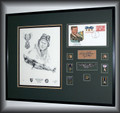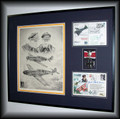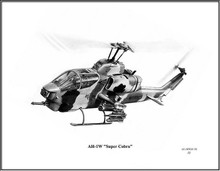 Loading... Please wait...
Loading... Please wait...Categories
Our Newsletter
- Home
- Combat Aircraft/Pencil Drawings ~ Free Shipping
- Bell AH-1W "Super Cobra" ~ Free Shipping
Product Description
***CLICK ON IMAGE TO ENLARGE***
Print Size 8½ x 11 ----- Unlimited print edition
The AH-1W Super Cobra is a two-place, twin-engine, day/night marginal weather Marine Corps attack helicopter that provides en route escort for assault helicopters and their embarked forces. It had been the only western attack helicopter with a proven air-to-air and anti-radar missile capability. The primary mission of the AH-1W aircraft is as an armed tactical helicopter capable of helo close air support, low altitude and high speed flight, target search and acquisition, reconnaissance by fire, multiple weapons fire support, troop helicopter support, and point target attack of threatening armor. The AH-1W provides fire support and fire support coordination to the landing force during amphibious assaults and subsequent operations ashore. The AH-1W is a two-place, tandem-seat, twin-engine helicopter capable of land- or sea-based operations. The rear seat pilot is primarily responsible for maneuvering the aircraft. The front pilot controls the aircraft's weapons systems, but also has a full set aircraft controls. The AH-1W distinguished itself with its more powerful T700-GE-401 fully marinized engines and advanced electronic weapons capability. The AH-1W has significantly improved power available in high altitude, hot environment, and single engine performance. The Super Cobra is armed with a 20mm turret gun, and is qualified to carry TOW, HELLFIRE, Sidewinder, Sidearm missiles, and 5 inch or 2.75 inch rockets. The HELLFIRE Missile System increased ordnance delivery and firepower capabilities. The AH-1W Super Cobra provides full night-fighting capability with the AN/AWS-1(V)1 Night Targeting System (NTS). The AN/AWS-1(V)1 NTS further enhanced the AH-1W's warfighting capability by adding FLIR sensor, CCD TV sensor, Laser Designator/Rangefinder, Automatic Target Tracking and FLIR, and CCD TV video recording. AH-1W assets have been comprised of a mixture of new production AH-1Ws and aircraft block upgrade AH-1Ts remanufactured into the AH-1W aircraft. By the early 1980s, USMC aircraft inventory was declining due to attrition. A fully navalized helicopter was sought. In 1983, the USMC contracted with Bell Helicopter International for 44 AH-1Ws. An upgrade to the AH-1T, the AH-1W was received in 1986. The Tactical Navigation System (TNS) was placed in all production and block upgrade AH-1W aircraft delivered since February 1991. Previously delivered AH-1Ws were retrofit with TNS prior to CCM/NTS induction. The NTS/Canopy/Cockpit Modification (CCM) replaces the existing canopy, nose faring, and copilot/gunner instrument panel to make provisions for the AN/AWS-1(V)1 NTS and added the TNS, CDU-800, to the front cockpit. Additionally, a communication/ navigation upgrade, ECP 1686, incorporated an ARC-210(V) Electronic Protection (EP) Radio, an ARN-153(V)4 TACAN, and an AN/ASN-163 Global Positioning System/Inertial Navigation System (EGI) commencing in 1996. The AN/AWS-1(V)1 NTS TECHEVAL was conducted from May through September 1993 by VX-5 at Naval Air Warfare Center, Weapons Division (NAWC-WD), China Lake, Yuma Proving Ground, Arizona, White Sands Missile Range, New Mexico, Bridgeport, California, and on amphibious ships at sea. Follow-on Operational Test and Evaluation (FOT&E) (OT-IIIA) commenced in February 1994 and concluded in May 1994. AN/AWS-1(V)1 NTS OPEVAL was conducted from May through September 1993 by VX-5 at Naval Air Warfare Center, Weapons Division (NAWC-WD), China Lake, Yuma Proving Grounds, Arizona, White Sands Missile Range, New Mexico, Cold Lake, Canada, and on amphibious ships at sea. Follow-on Operational Test and Evaluation (FOT&E) commenced during July 1994 and ended in April 1995. The AN/AWS-1(V)1 NTS upgrade provided increased mission, safety and performance characteristics and incorporated a Canopy/Cockpit Modification to the front cockpit. The approved OSIPs included the ARC-210(V) EP Radio, the ARN-153(V)4 TACAN and the AN/ASN-163 Global Positioning System/Embedded Inertial Navigation System (EGI). AN/ASN-163(V) was also expected to enhance the AH-1W Weapon Systems upon their incorporation. ECP 1674 Electronic Warfare (EW) Suite was also introduced to reduce aircraft vulnerability with electronic countermeasures. The suite was designed to alert and protect the aircraft from surface-to-air and air-to-air missiles. The AN/AAR-47 Missile Warning System (MWS) provides a visual and aural warning to flight crews of missile detection, while at the same time the MWS was designed to initiate countermeasures by sending an eject signal to the AN/ALE-39 Countermeasures Dispenser Set (CDS). The AN/AVR-2 Laser Warning Receiver detects pulsed laser light (such as a rangefinder) directed at the helicopter and warns the crew of this activity. It provided an audio alert and identifies the threat by its type and location relative to the helicopter. The AN/APR-39A(V)2 Radar Detection System (RDS) was a passive omni-directional detection system that received and displayed information to the pilot concerning the radar environment surrounding the helicopter. The AH-1W has been operated in eight composite HMLA squadrons composed of 18 AH-1 and 9 UH-1 aircraft. The NTS/FLIR upgrades were made to the AH-1W aircraft after its introduction into service. The Marine Corps deployed 4 of 6 active force squadrons (48 AH-1Ws) to Southwest Asia during Operation Desert Shield/Desert Storm. The deployment required no additional augmentation to squadron support personnel and only one Bell Helicopter technical representative. During Operation Desert Storm, the AH-1W comprised less than 20% of the attack helicopter force deployed, yet flew more than 50% of the total attack force flight-hours. In the entire Desert Shield/Desert Storm campaign, Super Cobras flew more than three times the number of hours per aircraft per month than any other attack helicopter. During the "100 Hour War," its reliability and 92% mission readiness rate were superior to all other attack helicopters by as much as 24% without any factory-supported maintenance augmentation. Perhaps most impressive, was that this record was amassed under some of the most adverse environmental conditions ever endured in modern warfare. Temperatures consistently reached the 57-63�C (135-145�F) range. A mix of fine granite/limestone sand dust the consistency of talcum powder, was a constant threat to man and machine. The air was often filled with a black concoction of burning oil and blowing sand The final result was that Marine Corps crews and their AH-1W destroyed 97 tanks, 104 armored personnel carriers and vehicles, 16 bunkers and two antiaircraft artillery sites. Future Upgrades included provisions for an Inflatable Body And Head Restraint System (IBAHRS). The IBAHRS itself would be incorporated upon receipt of the system. An operational requirement had been identified for a Wing Tip Armament Station modification and retrofit. Upon approval, this upgrade would be incorporated into the AH-1W airframe and would include as a minimum provisions for integration of up to six (6) universal weapons stations. The Cockpit Integration Requirement identified in the Operational Requirements Document for the AH-1W Mid Life Upgrade would be targeted by the 4 Bladed program which was being studied as another future AH-1W weapon system enhancement. This last improvement was ultimately incorporated into the AH-1Z upgrade.
Warranty Information
null








